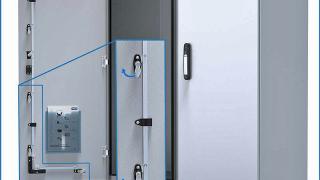
EMKA understands that the basic rule for all control cabinets is that the components inside, especially the sensitive electronic components, must be protected. However, there are significant differences, especially in the locking systems used. When special customer requirements have to be met on large cabinets, standardised locking systems sometimes reach their limits. However, EMKA's slimline multi-point locking systems frequently offer the right solution, by enabling the lock mechanism to release space on the door. This allows additional internal clearance, while providing exceptional closure capabilities.
Andy Billingham – MD at EMKA UK points out “Control cabinets are available in various shapes and designs, ranging from single cabinets to in-line cabinets or cabinets with double doors. All are available for indoor and outdoor applications. Environmental conditions and individual requirements significantly affect the choice of materials and the final design of the cabinet. But the cabinet alone does not adequately protect the internal components and electronics.”
He explains that “The locking and hinge solution is much more critical if the cabinet door is meant to seal securely and, if necessary, must withstand high pressure or fulfil other safety requirements. In order to find the most suitable closure and hinge solution, the environmental influences and the installation location are also decisive. Whilst housings used outdoors are mostly made of plastic and powder-coated steel, the material of choice remains stainless steel for very special applications.”
“The locking components should be made of the same material, regardless of material selection. Furthermore, high demands on tightness and the prevention of vandalism may have to be met in outdoor applications by using, for example, the IP65 protection class and security standards according to resistance classes.”
EMKA engineers have established that when designing control cabinets, a distinction is made between closures inside and outside the door seal. Locks inside the door seal are installed on interior doors and frequently outdoors. For example, a swing handle may be mounted on the door, which drives two locking bars inside the door – using either a drive or a locking cam. These systems compress the door seal and ensure a secure closure. EMKA has developed a unique compression latch system with multiple interlocking for closures inside the door seal. If using a rotating movement of a compression latch of only 90° – usually 180° – the door closes at several locking points which pulls the entire door evenly into the door seal even if the internal pressure is high.
Alternatively, the lock may be placed outside the seal so that, for example, no components protrude into the cabinet interior, the locking bars on the inside of the door are pushed into mounted locking points on the door frame with the door closed using a swinghandle or lifthandle.
The design of control cabinets demands the highest safety requirements for locking components. For example, the EMKA specialists for locking systems were asked to design an attractive swinghandle with resistance class RC2 for outdoor control cabinets for the Dutch IT system house Tecnolimit. This handle is easy to operate and can be monitored electronically.
Further information on slimline locking hardware from EMKA can be found at www.emka.com/uk_en/news/detail/locking-systems-for-large-control-cabinets/. Readers can find the latest information and news on the EMKA blog – www.emkablog.co.uk.